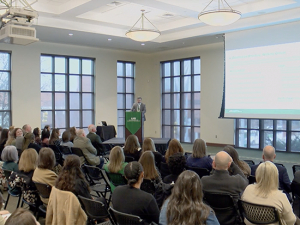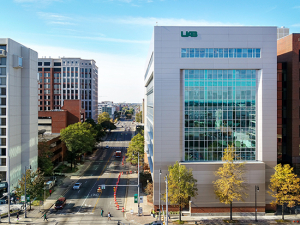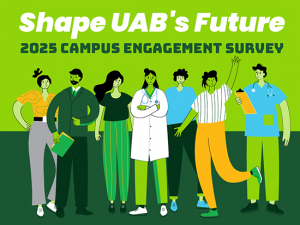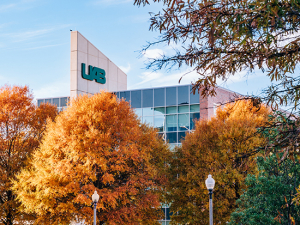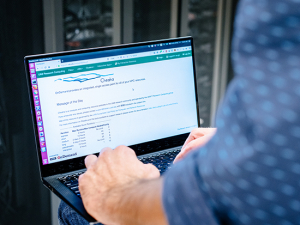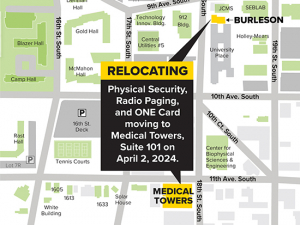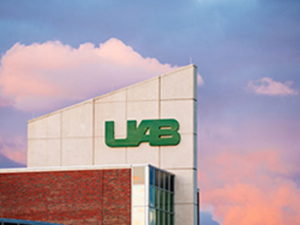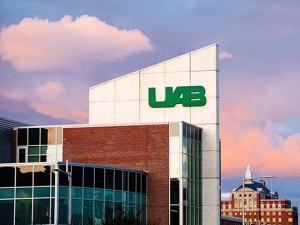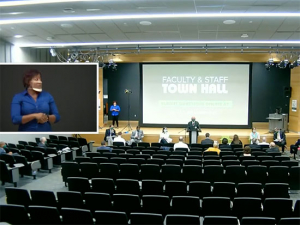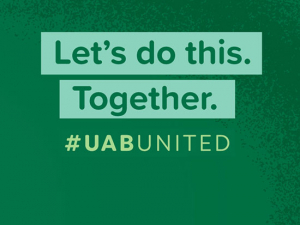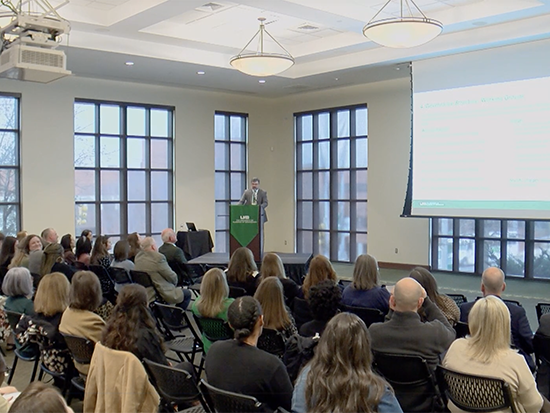 At a town hall meeting Feb. 24, senior leaders provided an overview of planning, progress, metrics and next steps for UAB’s SUCCESS Initiative. A video of the meeting is now available.
At a town hall meeting Feb. 24, senior leaders provided an overview of planning, progress, metrics and next steps for UAB’s SUCCESS Initiative. A video of the meeting is now available.
SUCCESS — which stands for Strategic and Unifying Campus Collaboration that Empowers Students to Succeed — is building a road map to continue UAB’s past decade of enrollment growth and improve student success across the university.
“A lot of people are energized around this effort to really help our students be as engaged as possible,” said President Ray Watts, M.D., in opening remarks. In fact, the event attracted a standing-room-only crowd at the Alumni House for the first detailed update on the initiative, which included an overview of the work completed so far, strategic priorities that have been identified and the metrics that will be used to measure success. In addition to enrollment growth, SUCCESS will work to increase retention and graduation rates at UAB.
Watts noted that the graduation rate for UAB’s student-athletes is among the highest in the entire student body. “That is because they have a wraparound program to make sure they are staying on track for academic achievement,” Watts said. “We know that, the more support we give our students, the more likely they are to be successful.”
Provost Janet Woodruff-Borden, Ph.D., explained that “SUCCESS is designed to address the challenging enrollment environment faced by UAB and universities nationwide and to transform student support through the collaborative efforts of faculty and staff across campus.” The initiative represents “the coming together of our entire institution to provide a robust and seamless experience for students,” Woodruff-Borden said. “We have collaboratively worked to establish a road map, but it is going to take buy-in from all across UAB.” That is because the goal is no less than “working toward a transformative change” that will require strategic investments in people and programs, she added.
Scroll down to read a summary of the town hall, or use the links to jump to specific points in the discussion:
Strategic priorities and governance structure
SUCCESS goals and metrics dashboard
Critical success factors and risks; SUCCESS website
Project approach
Bradley Barnes, Ph.D., senior vice provost for Enrollment Management and Student Success, provided an overview of the project approach to SUCCESS. The initiative launched with a discovery phase in August 2024 that included the engagement of Ruffalo Noel Levitz consulting services to better understand UAB’s current strengths and opportunities for improvement. The team from RNL interviewed faculty, staff, students and administrators across campus, reviewed UAB’s organizational structure, and assessed current practices.
Several key themes emerged from that work, Barnes said. Others were identified in a November 2024 survey sent to faculty, staff and administrators campus-wide. There were 712 completed survey responses, including 40% from faculty members, 52% from staff and 8% from administrators, Barnes said. Respondents shared more than 250 comments and suggestions as part of the survey.
Strategic priorities and governance structure
Campus feedback and RNL recommendations informed the selection of seven strategic priorities as part of the analysis and planning phase of the SUCCESS Initiative in November and December 2024:
- Amplify pathways for enrollment growth
- Enhance recruitment, engagement and support of transfer students
- Operationalize student engagement (for first- and second-year students)
- Improve UAB’s data-management plan
- Expand student marketing and communication efforts
- Improve student retention awareness
- Achieve student health and well-being
The initiative’s governance structure, Barnes explained, begins with an Executive Steering Committee that serves as a liaison to President Watts and provides oversight and direction for key decision-making. (See the committee membership on the SUCCESS site.)
The Executive Steering Committee is supported by seven working groups — one for each of the seven strategic priorities — that are each led by two co-chairs and consist of 83 total stakeholders from across campus with a vested interest and expertise in enrollment and student success areas. (See a list of working group members and their school/unit affiliations here.)
Each working group is charged with meeting at least twice per month and drafting an annual work plan by May 2025, Barnes said. The working groups have the latitude to create subgroups as needed with additional members in related fields from the campus community, he noted.
UAB deans, through the UAB Deans Council, are also a part of the governance structure and will incorporate plans related to the SUCCESS Initiative in their schools’ strategic plans, Barnes said.
SUCCESS goals and metrics dashboard
The Executive Steering Committee has identified four goals, and metrics to measure progress toward those goals, Barnes said.
Goal 1: Increase total enrollment (a 5% increase over the next five years, or 1% per year, from a fall 2024 baseline of 20,905 students).
Goal 2: Increase retention of first-time, full-time freshmen (an increase of 2.9 percentage points, from a fall 2023 cohort baseline of 80.1%).
Goal 3: Improve the four-year and six-year graduation rates (improve the four-year rate to 55% from a baseline of 50.5% for the fall 2020 cohort; improve the six-year rate to 70% from a baseline of 62.4% from the fall 2019 cohort).
Goal 4: Increase the quality of and participation in support services (Career Center, counseling, academic support), programs (co-op training, internships, community engagement, undergraduate research and study abroad) and resources.
Eva Lewis, Ph.D., vice provost for Institutional Effectiveness and Academic Planning, offered a sneak peek at the online dashboard being developed to track progress toward each of these metrics, which will be added to the SUCCESS website soon and updated regularly as reporting begins in September 2026 and onward.
Critical success factors and risks; SUCCESS website
Barnes concluded the presentation by sharing an illustration frequently used by John Jones, Ph.D., vice president for Student Affairs, who is co-chair of the Executive Steering Committee along with Woodruff-Borden.
It is hard to see the whole campus at once, Barnes said, much like a group of blindfolded people, each feeling an elephant at various parts, may interpret it as a snake, wall or rope. “Each of us sees and knows the portion of the work that is ours,” Barnes said. The goal of the SUCCESS Initiative, he said, is “to transform the way we work together.”
That will require a focus on change management at all levels, stakeholder engagement, collaboration across units and creative solutions to resource needs, Barnes said. It also will require overcoming cultural barriers to change and prioritizing resources in a difficult external environment.
Chandni Khadka, project director for Strategic Initiatives in the Office of the President, demonstrated resources available on the newly launched SUCCESS Initiative website. In addition to information on the project’s phases and governance structure, the site includes a detailed report on results and feedback from the SUCCESS survey, campus communications about the initiative, and an online form where members of the UAB community can give feedback or ask questions. The metrics dashboard, once finalized, will be housed on the site as well, Khadka said.
Questions
The town hall concluded with questions submitted by audience members. A summary of questions and answers is below. Hear all questions and responses, starting at 36:40 in the video here.
Q: Does the SUCCESS Initiative apply to graduate enrollment/retention as well as undergraduate?
A (Barnes): Yes, there will be a focus on graduate as well as undergraduate enrollment and success.
Q: If you are not part of a working group, how can you contribute to this initiative?
A (Barnes): Look for opportunities to serve as a sub-group member. Attend this year’s student success summit, scheduled for May 14, 2025, at a time TBD in the Hill Student Center, which will focus on the SUCCESS Initiative and ways to contribute. You may also submit input and ideas via the form on the website [located here].
Q: How will the larger campus be informed of progress?
A (Khadka): We will use the eReporter email to send out major updates and keep the website updated on an at least monthly basis.
Q: How many students are involved in the initiative?
A (Barnes): Students are not part of the working groups, but Dr. Jones has mentioned taking updates to students and gathering feedback. Also, subgroups can include students.
